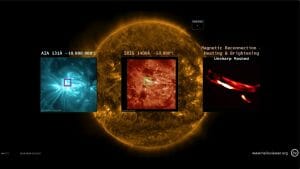It is zoomed in from the leftmost frame to the rightmost frame. The loops (loops) that are presumed to be nanoflares are reflected in the rightmost frame. (Image Credit: NASA / SDO / IRIS / Shah Bahauddin)
NASA on December 21st“Nanoflare”Announced that it may have succeeded in observing.“Flare”Is an explosion phenomenon that occurs on the surface of the sun,Nano flareIsA small flare about one billionth of a normal flareIs called.This nanoflare is so-called“Corona heating problem”It is believed to hold the key to the solution.
The surface temperature of the sunAbout 6000 ℃is.However“corona”The temperature of the upper part of the sun’s atmosphere is calledMillions of °CIt will also be. So why is the temperature of the corona a little further away from the surface of the sun warmer than that of the surface of the sun? This problem is called the corona heating problem.
The mechanism has not yet been fully elucidated, but there are two powerful ideas.Suppose the corona is heated by the waves transmitted through the plasma.“Wave heating theory”And assume that the corona is heated by nanoflares“Nanoflare theory”is.
Large flares and medium flaresWe already know that it is not enough to keep the temperature of the corona. Therefore, in the nanoflare theory, in addition to large-scale flares and medium-scale flares, it is thought that the corona is steadily warmed by nanoflares.
However, no nanoarea has ever been actually observed.
A research team led by Shah Bahaudin of the University of Colorado originally studied small bright loops that shimmer in the layers just below the corona, but NASA’sSolar Observation Satellite IRISFrom the data in, the temperature of this loop is higher than the ambient temperatureMillions of °CIt turned out that it was also expensive. This was totally unexpected.
So the research teamsimulationWhen I did, the loop in question“Magnetic reconnection”It turned out that it was caused by a phenomenon called.
Magnetic reconnection is a phenomenon in which once a magnetic line of magnetic force is cut off, it is reconnected with another line of magnetic force, which generates enormous heat. Large and medium flares are believed to be caused by this magnetic reconnection. So the loop in question was triggered by the same mechanism as large and medium flares.
Also, NASASolar observation satellite SDOIt was also confirmed from the observation data of that that the corona directly above the loop was heated to millions of degrees Celsius immediately after the loop in question appeared.
However, the research team is still avoiding the assertion that this loop is nanoflare, although it is likely.
The research team now wants to see if the loop in question is occurring throughout the sun and often enough to heat the entire corona.
Perhaps the day when the corona heating problem, one of the long-standing mysteries of astronomy, will finally be resolved.
Image Credit: NASA / SDO / IRIS / Shah Bahauddin
Source: NASA
Sentence / Shigeyuki Iido
Related article link (external site)
The distance from the solar system to the galactic center is about 25,800 light-years.Observation results by VLBI in Japan
Jupiter’s South Pole and layers seen from below
Regular self-assertion caused by a lonely small galaxy



